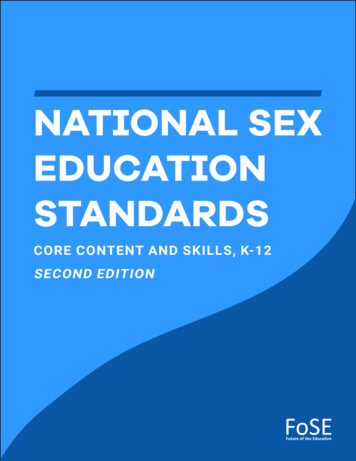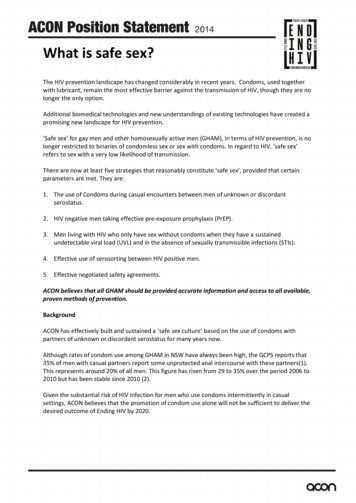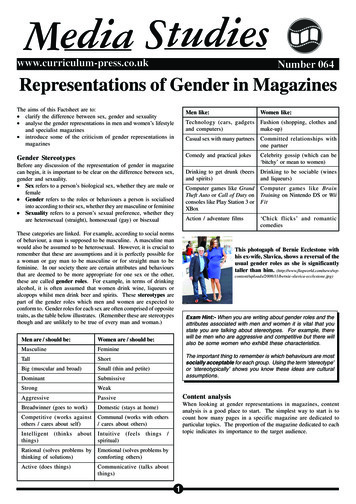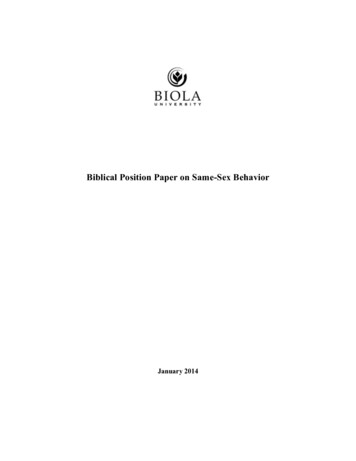
Transcription
NATIONAL SEXEDUCATIONSTANDARDSCORE CONTENT AND SKILLS, K-12SECOND EDITION
National Sex Education Standards: Core Content and Skills, K–12 (Second Edition)National SexEducation StandardsCORE CONTENT AND SKILLS, K-12SECOND EDITION2
Table of ContentsAcknowledgements2Contributors and Reviewers3Endorsements4Testimonials5Background and Vision6Purpose of the National Sex Education Standards7What’s New in this Edition of the National Sex Education Standards8Guiding Principles and Values for the National Sex Education StandardsHigh ExpectationsFunctional Knowledge and SkillsTrauma-InformedSocial, Racial, and Reproductive Justice and EquityIntersectionalityLanguage Inclusivity10101010111111Theoretical Framework12Characteristics of Effective Comprehensive Sex Education12Alignment with Existing Education Standards13Organization and Design of the Revised NSES15References17Standards by Grade Level dards by Topic StrandConsent and Healthy Relationships (CHR)Anatomy and Physiology (AP)Puberty and Adolescent Sexual Development (PD)Gender Identity and Expression (GI)Sexual Orientation and Identity (SO)Sexual Health (SH)Interpersonal Violence (IV)3434353739414751
National Sex Education Standards: Core Content and Skills, K–12 (Second Edition)AcknowledgementsThe National Sex Education Standards: Core Content and Skills, K–12 (Second Edition) were developed by theFuture of Sex Education (FoSE) Initiative, a partnership between Advocates for Youth, Answer, and SIECUS: SexEd for Social Change that seeks to create a national dialogue about the future of sex education and to promote theinstitutionalization of quality sex education in public schools. To learn more, please visit www.futureofsexed.org.Advocates for Youth partners with youth leaders, adult allies, and youth-serving organizations to advocate for policiesand champion programs that recognize young people’s rights to honest sexual health information; accessible,confidential, and affordable sexual health services; and the resources and opportunities necessary to create sexualhealth equity for all youth. Advocates for Youth envisions a society that views sexuality as normal and healthy andtreats young people with respect. Advocates’ vision is informed by its core values of Rights. Respect. Responsibility.Answer provides and promotes unfettered access to comprehensive sexuality education for young people and theadults who teach them. Answer envisions a nation in which sexuality is recognized as a normal, healthy part ofdevelopment and every young person’s right to high-quality sex education is fulfilled. For nearly 40 years, they havehelped adults be the best sexuality educators they can be by providing the latest resources, most current informationand best practices for reaching and teaching the young people in their lives. Answer is also dedicated to ensuringyoung people have access to the information they need to be happy, healthy, and safe well into the future.SIECUS: Sex Ed for Social Change has served as one of the national voices for sex education for 55 years, assertingthat sexuality is a fundamental part of being human, one worthy of dignity and respect. SIECUS works to create aworld that ensures social justice is inclusive of sexual and reproductive rights. Through policy, advocacy, education,and strategic communications efforts, SIECUS advances sex education as a vehicle for social change—working towarda world where all people can access and enjoy their own sexual and reproductive freedom. 2020 Future of Sex Education InitiativeSuggested citation: Future of Sex Education Initiative. (2020). National Sex Education Standards: Core Content andSkills, K-12 (Second Edition).This publication was generously supported by a grant from the Grove Foundation.The FoSE partners wish to thank Jennifer Heitel, consultant to the FoSE Initiative, for her hard work and dedication.2
Contributors and ReviewersContributors and ReviewersA diverse group of professionals with expertise in sexuality, public education, public health, child and adolescentmedicine, social justice, and psychology provided valuable contributions to and feedback on drafts of the revisedNational Sex Education Standards. FoSE is grateful to these individuals:Brittany Batell, MPH, MSW, Program and Engagement Manager,Michigan Organization on Adolescent Sexual HealthLaurie Bechhofer, MPH, HIV/STD Education Consultant,Michigan Department of EducationJacqueline Bible, MA, Consultant, Future of Sex EducationInitiative Diana K. Bruce, MPA, Director of Health and Wellness, Districtof Columbia Public Schools Nicole Cushman, MPH, Executive Director, Answer Jennifer Driver, Vice President of Policy & StrategicPartnerships, SIECUSBonnie J. Edmondson, EdD, Associate Professor, SchoolHealth Education Graduate Program Coordinator, SouthernConnecticut State UniversityJey Ehrenhalt, MEd, School Programs Coordinator, TeachingTolerance (A Project of the Southern Poverty Law Center)Mariotta Gary-Smith, MPH, CSE, Founding Member, Women ofColor Sexual Health NetworkAndrea Gleaves, Strategic Partnerships Manager, DC CoalitionAgainst Domestic ViolenceNora Gelperin, MEd, Director of Sexuality Education andTraining, Advocates for YouthEva S. Goldfarb, PhD, LHD (hon), Professor, Public Health/Human Sexuality, Montclair State UniversityChristine Soyong Harley, MPP, President and Chief ExecutiveOfficer, SIECUSDebra Hauser, MPH, President, Advocates for YouthJennifer Heitel, MPH, Consultant, Future of Sex EducationInitiativeElis Herman, Health Education Specialist–Sonoma County,Planned Parenthood Northern CaliforniaLisa James, Director of Health, Futures Without ViolenceTonya Katcher, MPH, MD, Program Director for ClinicalServices and Contraceptive Access, Advocates for YouthNiki Khanna, MA, AMFT, ConsultantJoseph Kosciw, PhD, Director, GLSEN Research InstituteMaureen Kenny Winick, PhD, Professor, School of Educationand Human Development, Florida International UniversityLisa D. Lieberman, PhD, CHES, Professor, Public Health,Montclair State UniversityStephanie Morris, MBA, Chief Executive Officer, SHAPEAmericaLinda Morse, RN, NJ-CSN, MA, RCHES, Retired, NJ Departmentof EducationSonya M. Norsworthy, MAOM, National Director of Education,Planned Parenthood Federation of AmericaChitra Panjabi, MA, President and Chief Executive Officer,SIECUS Daniel Rice, MEd, Interim Executive Director, AnswerDeborah Roffman, MS, CSE, Sexuality Educator and ConsultantEmily Rothman, ScD, Professor, Boston University School ofPublic HealthElizabeth Schroeder, EdD, MSW, Principal, Elizabeth SchroederConsultingWendy L. Sellers, RN, MA, President and Sexuality Educator,Health 4 HireAl Vernacchio, MSEd, Sexuality Educator, Friends’ CentralSchool, Wynnewood, PACaitlin Viccora, Program Coordinator, Supportive & HealthySchools, Advocates for YouthKim Westheimer, MA, Director of Strategic Initiatives, GenderSpectrumSandy Wurtele, PhD, Professor of Psychology, University ofColorado at Colorado SpringsFred Wyand, Director of Communications, American SexualHealth AssociationOrganizational affiliations are included for identification purposes only.Individuals represented the organization listed above duringcreation of the NSES but have since moved on.3
National Sex Education Standards: Core Content and Skills, K–12 (Second Edition)Endorsing Organizations4
TestimonialsTestimonials“It is critical for young people to embrace the normal changes of puberty and to ultimately engage in positive andhealthy sexual decision-making. The importance of clear, evidence-based guidance for sexuality education cannot beunderestimated. These updated standards provide high-quality, evidence-based information with proven strategiesto teach young people about sexual and reproductive development in a thoughtful and nonjudgmental manner.”- Maria Trent, MD, MPH, FAAP, FASHMProfessor of Pediatrics, Public Health, and Nursing, Johns Hopkins UniversityPresident, Society for Adolescent Health and Medicine“The National Sex Education Standards provide much needed content and skills to help children and adolescentsgrow up to be healthy adults with responsible approaches to sexuality, consent, and sexual behavior. The secondedition of the Standards incorporate emerging evidence about how to address unconscious biases, trauma informedcare, and gender identity, among others. They provide a clear approach, recognizing that comprehensive schoolhealth programs should provide both age-appropriate information about human development and support for thecritical role of families in setting values.”- Jonathan D. Klein, MD, MPHNorth American Vice President, International Association for Adolescent HealthSamuel and Savithri Raj, Endowed Professor and Executive Vice Head,Department of Pediatrics, University of Illinois at Chicago“Today, about one in five young women and gender non-confirming people report experiencing some kind of sexualassault while in college. It is essential that students learn about consent, bodily autonomy and mutual respect froman early age. The National Sex Education Standards provide guidance to schools on what to teach in each grade levelto help reduce sexual harrassment and assault and instead raise a generation of young people committed to a cultureof consent.”- Sage Carson, Manager, Know Your IX“When followed, these updated standards will help to ensure that youth of all orientations, gender identities andexpressions have access to information needed to make informed decisions to support happy and healthy futures forthemselves and their peers.”- Dr. Eli R. Green, Founder & CEO, The Transgender Training Institute, Inc“SHAPE America envisions a nation where all children are prepared to lead healthy, physically active lives. Providingaccess to sexual health information is an important part of ensuring young people have the knowledge and skillsneeded to make informed decisions about their health. These standards are a road map for K-12 administrators andeducators who are committed to providing their students with the imperative content they deserve to grow intohealthy adults.”- Stephanie Morris, Executive Director, SHAPE America“Over the past decade we have seen a reawakening on a number of sexual health issues, including a newdialogue about sexual consent, the emergence of digital technologies shaping sexual health, greater awareness ofintersectionality, and fundamental connections among sexual orientation and gender identity and the long-termconsequences of stigma and discrimination. We have also seen the emergence of new language about social, racial,and reproductive justice and equity that reflect this reawakening. All of these are reflected in the 2020 National SexEducation Standards.”- John Santelli, MD, MPHProfessor, Population and Family Health and Pediatrics, Columbia UniversityPast-President, Society for Adolescent Health and Medicine5
National Sex Education Standards: Core Content and Skills, K–12 (Second Edition)Background and VisionThe National Sexuality Education Standards: Core Content and Skills, K–12 (NSES) were first published in 2012. Thedevelopment of these standards, and this update, have been the result of an ongoing initiative, the Future of SexEducation (FoSE). For the first edition of these standards, forty individuals from the fields of health education, sexeducation, public health, public policy, philanthropy, and advocacy convened for a two-day meeting in December 2008to create a strategic plan for sex education policy and implementation. A key strategic priority that emerged from thiswork was the creation of national sex education standards to advance the implementation of sex education in UnitedStates (US) public schools. In this updated edition, the FoSE partners first conducted an internal review of the NSES,taking into account feedback received through seven years of implementation. In addition, a number of experts indifferent topic areas conducted external reviews, and FoSE held a daylong in-person expert consultation meeting inJanuary 2018.Research shows that quality sex education programs can help young people delay the onset of sexual activity, reducethe frequency of sexual activity, reduce their number of sexual partners, and increase condom and contraceptiveuse.1 And, by helping young people avoid unintended pregnancy and sexually transmitted diseases/infections (STDs/STIs), these programs can yield additional benefits. During the younger years, education that includes identifyingbody parts and safe versus unsafe touching, and discusses reporting child sexual abuse increases self-protectiveknowledge and skills, awareness that child sexual abuse is not the fault of the child, and makes it more likely fora child to say they would tell someone about the abuse.2 And for older youth, students who receive sex education,including sexual negotiations skills, before college matriculation are at lower risk of experiencing sexual assaultduring college.3These programs have also been found to help young people succeed academically by helping them to stay in schooland achieve higher grades.4 They also increase acceptance of students who identify as lesbian, gay, bisexual,transgender, queer or questioning (LGBTQ), many of whom are at disproportionate risk for school absenteeism,dropping out, bullying, and detrimental sexual health outcomes such as the human immunodeficiency virus(HIV), other STDs/STIs, and unintended pregnancy.5-6 Academic achievement and the health status of students areinterrelated and should be recognized as such. Physical and emotional health-related problems may inhibit youngpeople from learning by reducing their motivation to learn; diminishing their feelings of connectedness to school;and contributing to absenteeism and drop out.7-8The goal of sex education is to help young people navigate sexual development and grow into sexually healthyadults. To be effective, sex education must include medically accurate information about a broad range of topicssuch as consent and healthy relationships; puberty and adolescent development; sexual and reproductive anatomyand physiology; gender identity and expression; sexual identity and orientation; interpersonal and sexual violence;contraception, pregnancy, and reproduction; and HIV and other STDs/STIs. Quality sex education goes beyonddelivering information. It provides young people with opportunities to explore their own identities and valuesalong with the values and beliefs of their families and communities. It also allows young people to practice thecommunication, negotiation, decision-making, and assertiveness skills they need to create healthy relationships—both sexual and nonsexual—throughout their lives.6
Purpose of the National Sex Education StandardsPurpose of the National SexEducation StandardsThe goal of the National Sex Education Standards: Core Content and Skills, K–12 (Second Edition) is:To provide clear, consistent, and straightforward guidance on the essential, minimum, core content and skillsneeded for sex education that is age-appropriate for students in grades K–12 to be effective.The NSES were originally developed to address the inconsistent implementation of sex education nationwide and thelimited time allocated to teaching the topic—and this mission still stands. According to the Centers for Disease Controland Prevention’s (CDC’s) School Health Policies and Practices Study (SHPPS), 41.3% of districts in the US have adoptedthe NSES.) with: According to the Centers for Disease Control and Prevention’s (CDC’s) School Health Policies andPractices Study (SHPPS), 41.3% of districts in the US follow standards based on the NSES. According to SHPPS, teachersprovided an average of 6.2 hours of instruction on human sexuality in high school courses, with an average of less thanfour hours on HIV, other STDs, and pregnancy prevention. In middle school courses, teachers provided an average of 5.4total hours of instruction on human sexuality, with just over two hours on HIV, other STDs, and pregnancy prevention.And in elementary schools, teachers provided only 1.9 hours on human sexuality.10 In addition, a median of only 17.6% ofschools taught all 20 specific sexual health topics included in the SHPPS questionnaire in grades 6, 7, or 8, and a medianof only 42.8% taught all of these topics in grades 9, 10, 11, or 12. Notably, the median percentages were higher across largeurban school districts (41% and 75%, respectively). Of note, HIV prevention topics are losing ground in school healtheducation. Since 2008, the percentage of schools across states that taught HIV prevention topics fell from 93% to 87% in2018.11Given these realities, the National Sex Education Standards aim to: Outline, based on research and extensive professional expertise, the minimum, essential, corecontent and skills for sex education K–12 given student needs. Provide guidance for schools when designing and delivering sex education K–12 that is planned,sequential, and part of a comprehensive school health education approach. Provide a clear rationale for teaching sex education content and skills at different grade levels that isevidence-informed, age-appropriate, and theory-driven. Support schools in improving academic performance by addressing a content area that is both highlyrelevant to students and directly related to academic success and high school graduation rates. Present sexual development as a normal, natural, healthy part of human development that everyschool district should address. Offer clear, concise recommendations for school personnel on what is age-appropriate to teachstudents at different grade levels. Translate an emerging body of research related to school-based sex education so that it can be putinto practice in the classroom. Address the ever-evolving learning needs of students, including as it related to emerging topics ofsex and sexuality. Ground the educational experience in social justice and equity, honoring the diversity of students(racial, ethnic, gender, orientation, ability, socio-economic, as well as academic) and promoteawareness, understanding, and appreciation of diversity and inclusion.7
National Sex Education Standards: Core Content and Skills, K–12 (Second Edition)The NSES outline what all students are expected to know and be able to do at a specific stage of their education, nothow teachers should teach or the curricula they should use. The NSES describe education indicators, focusing onwhat is most essential for students to learn by the end of a grade level or grade span, rather than describe all that canor should be taught. The NSES are written to identify the key concepts and skills that students broadly need to besexually healthy during their school-age years and throughout the lifespan. The NSES can be used to create lessonsand/or curricula with learning objectives that will achieve the standards. The NSES are voluntary guidance and donot ascribe or mandate any particular teaching practice, curriculum, or assessment method by an authorizing body.A great deal is left to the discretion of educators, administrators, and curriculum developers.What’s New in this Edition of theNational Sex Education StandardsIt has been nearly 10 years since the first edition of the NSES was created and released. This new edition takes intoaccount lessons learned from implementation by states and school districts around the U.S. and reflects recentdevelopments, research advancements, and current thinking on a number of topics.As detailed below, the updated NSES have been written with a trauma-informed lens; have been infused withprinciples of reproductive justice, racial justice, social justice, and equity; address social determinants of health andhow these can lead to inequitable health outcomes; and take an intersectional approach. This edition uses less cisand heteronormative language that reflects a broader range of relationships and identities. It also prioritizes bothcontent and skill-based learning to acknowledge that it is essential to couple functional knowledge with skills to helpsupport healthy decision-making. Increased attention also has been paid to strategically scaffold concepts and skillsin order to introduce topics at age-appropriate grade levels, reflecting recent research that supports introducing sometopics earlier while preparing students for more complex content and skills as they age.12-15Educators and administrators who have adopted or used the NSES as guidelines for their own standards, curricula,and teaching, asked for more specificity regarding which topics should be taught at which grade level, particularly atthe youngest and oldest ages. This updated version now presents core content and skills in more specific grade levelbands to better reflect what is age-appropriate. The updated NSES use the following grade bandwidths: grades K–2,grades 3–5, grades 6–8, grades 9–10, and grades 11–12.The updated NSES also include new topics to provide increased guidance to educators on a number of issuespreviously unaddressed and new indicators and topic strands to better address what is age-appropriate for students.Additions and updates to indicators and topics reflect:8 advancements in medical technologies; developments in communications platforms, including social media, and the increasing use andimpact of technology within relationships; increased focus on bodily autonomy, consent, and sexual agency; updated laws and policies on such topics as bullying, sexting, and access to and availability ofsexual and reproductive healthcare; continual evolution in language related to gender, gender identity, gender expression, sexualorientation, and sexual identity; inclusion of power and privilege, conscious and unconscious bias, intersectionality, and covert andovert discrimination, and the principles of reproductive justice, racial justice, social justice,and equity;
What’s New in this Edition of the National Sex Education Standards emphasis on prevention, recognition, and intervention related to sex trafficking and sexualexploitation; and impact of youth having increased availability and access to sexually explicit media.In addition, the new NSES is updated with new topic strands as follows.Original NSESHealthy Relationships (HR)Revised NSESTopic strand title changed to:Consent and Healthy Relationships (CHR)Anatomy and Physiology (AP)What is reflected in this change?Includes all indicators related torelationships, both specific andgeneral. Adds emphasis on the topicof consent and starts to focus onconsent and bodily autonomy inearly elementary in order to helpkeep young students safe from childpredators and lay the groundworkfor an understanding of sexualrelationships much later on, aswell as ensuring a safer classroomenvironment in the present.Topic strand title unchanged:Anatomy and Physiology (AP)Puberty and AdolescentDevelopment (PD)Topic strand title changed to:Identity (ID)Broken into two topic strands:Puberty and Adolescent SexualDevelopment (PD)1) Gender Identity and Expression (GI)2) Sexual Orientation and Identity (SI)Pregnancy and Reproduction(PR) and Sexually TransmittedDiseases and HIV (SH)Merged into one topic strand:Personal Safety (PS)Topic strand title changed to:Sexual Health (SH)Interpersonal Violence (IV)Better reflects the focus on sexualdevelopment in adolescence, ratherthan all adolescent development.Better reflects that these areseparate areas of identity thatshould not be conflated.Takes a more holistic approachto what it means to be sexuallyhealthy. Better reflects the overlap inknowledge and skills necessary forprevention, care, and treatment ofpregnancy and STDs, including HIV.Better reflects all types of violence(e.g., bullying, sexual harassment,sexual abuse, sexual assault,dating violence, domestic violence)that may occur in a variety ofrelationships (e.g., peer-to-peer,family, romantic, sexual).9
National Sex Education Standards: Core Content and Skills, K–12 (Second Edition)Guiding Principles and Valuesfor the National Sex EducationStandardsHigh ExpectationsThe National Sex Education Standards ascribe to the educational principle of high expectations, which is premisedon the philosophical and pedagogical belief that holding all students to high expectations provides access to ahigh-quality education, since the educational achievement of students tends to rise or fall in direct relation tothe expectations placed upon them. Although recommendations made here are based on grade level, children ofthe same age often develop at different rates and some content may need to be adapted based on the needs of thestudents. The NSES do not provide specific guidance on how a topic area should be taught. They also generally do notaddress varying needs of students with intellectual and/or physical disabilities or who are neuroatypical or studentswith any other unique attributes who may require adjustments to instruction. All students, regardless of physicalor intellectual ability, deserve the opportunity to achieve personal health and wellness, including sexual health.Educators and other school professionals, including administrators, should create and/or provide the additionalsupport materials necessary to ensure that teaching is developmentally appropriate and culturally relevant for thosewith unique learning needs, including English learners and students with differing abilities.Each district, school, administrator, and educator knows best the context in which they are teaching and are inthe position to best identify the needs of their students and the strategies, materials, time, and resources needed tosupport students in achieving the NSES. Curriculum planners should implement existing or develop new curriculabased on local health needs. It is up to curriculum developers, administrators, and educators to ensure all studentshave the opportunity to learn and meet the same high standards. Students need multiple opportunities and avariety of assessment strategies to determine whether educators have achieved effective implementation of the sexeducation standards.Functional Knowledge and SkillsIn revising the NSES, the authors took into account the current evolution of understanding regarding the importanceof functional knowledge and skill. Sexuality education experts maintain that skills, such as those outlined in theNational Health Education Standards, are essential to the development and maintenance of sexual health throughoutthe lifespan. These same experts agree there is unique and nuanced content in sexual health that is critical forstudents to learn in order to lay a strong foundation for the effective application of skills. As such, the NSES includeindicators related both to functional knowledge and skills.Trauma-InformedThe NSES have been written with a trauma-informed lens and the understanding that the experiences of bothstudents and teachers impact what happens in a classroom. Many people have experienced interpersonal or sexualviolence or other trauma related to sexual harassment and assault, sexual orientation, gender identity or expression,race, socio-economic status, ability, immigration status, religion, and/or culture. Consequently, some teachers mayneed additional support when addressing these issues to ensure they approach these topics sensitively and do notinadvertently re-traumatize students. As a guiding principle, educators should always utilize trauma-informedstrategies when implementing sex education. This includes, for example, giving trigger warnings before beginningto teach content on sexual violence and allowing students the right to pass as appropriate. Indicated throughout theNSES with an asterisk (*) are places where educators may want to include a trigger warning before introducing anddiscussing sensitive material related to interpersonal or sexual violence or other trauma.10
Guiding Principles and Values for the National Sex Education StandardsSocial, Racial, and Reproductive Justice and EquitySex education should avoid cisnormative, heteronormative approaches, aim to strengthen young people’s capacity tochallenge harmful stereotypes, and be inclusive of a wide range of viewpoints and populations without stigmatizingany group. It should acknowledge the role that structural and contextual factors—personal, interpersonal, social,economic, and cultural—play in shaping adolescents’ sexual motivations and behaviors, with the fundamental goalof removing economic-, racial-, ethnic-, gender-, sexual orientation-, and ability-related disparities in adolescentsexual health. Health outcomes are largely influenced by biology and genetics, individual behavior, socialenvironment, physical environment, and availability of health services.16-17 These factors interact and influencehealth outcomes for individuals.18 Given this, the updated NSES calls attention to overt and covert discrimination,which may be based on biases, including institutional, structural, interpersonal, and internalized racism. TheStandards also reflect a focus on conscious and unconscious bias to avoid possibly perpetuating stereotypes. Socialdeterminants of health are also addressed with a focus on how characteristics such as to race, ethnicity, socioeconomic status, sexual orientation, and gender identity and expression are related to inequitable health outcomes.All adolescents have a right to comprehensive, developmentally and culturally appropriate, confidential supportand sexual health services. And, if pregnant, young people have the right to comprehensive pregnancy optionscounseling and all related services. The updated NSES have thoughtfully taken into consideration that youngpeople—including young people who are pregnant or parenting—should have decision-making power in theirreproductive health and their decision to determine if, when, and under what circumstances they do or do not wantto parent. Within
Suggested citation: Future of Sex Education Initiative. (2020). National Sex Education Standards: Core Content and Skills, K-12 (Second Edition). Contributors and Reviewers 3 Contributors and Reviewers A diverse group of professionals with expertise in sexuality, public










